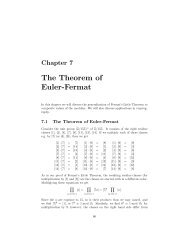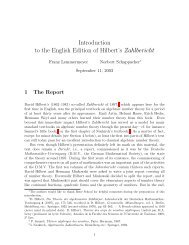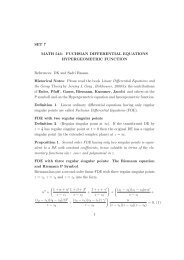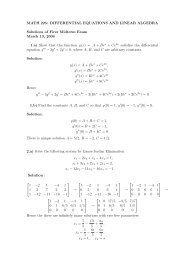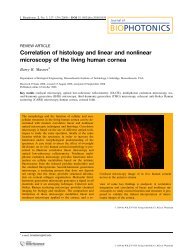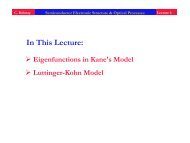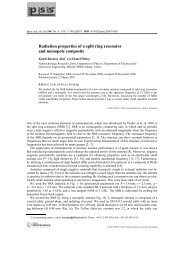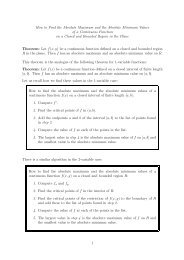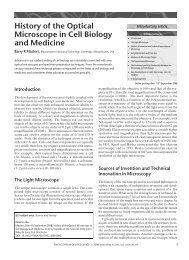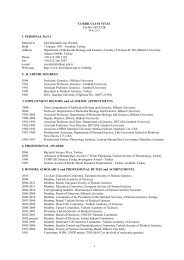Jump processes in surface diffusion - Bilkent University - Faculty of ...
Jump processes in surface diffusion - Bilkent University - Faculty of ...
Jump processes in surface diffusion - Bilkent University - Faculty of ...
Create successful ePaper yourself
Turn your PDF publications into a flip-book with our unique Google optimized e-Paper software.
44 G. Antczak, G. Ehrlich / Surface Science Reports 62 (2007) 39–61<br />
Fig. 11. Arrhenius plot for <strong>in</strong>- and cross-channel <strong>diffusion</strong> <strong>of</strong> Ni on Ni(110)<br />
plane [15]. Left: Substrate after thermal treatment. Right: Nickel substrate had<br />
been hydrogen fired and field evaporated before experiments.<br />
Fig. 9. Adatom trajectories <strong>in</strong> <strong>diffusion</strong> on fcc(110) plane at 0.4T m [11].<br />
Transitions across the [1¯10] channels are apparent.<br />
Fig. 12. Self-<strong>diffusion</strong> <strong>of</strong> Pt on Pt(110) <strong>surface</strong> [18]. In-channel <strong>diffusion</strong>:<br />
E D = 0.72 ± 0.07 eV, D o = 6 × 10 −4 cm 2 /s. Cross-channel <strong>diffusion</strong>:<br />
E D = 0.69 ± 0.07 eV, D o = 3 × 10 −4 cm 2 /s.<br />
Fig. 10. Early Arrhenius plot for the cross-channel <strong>diffusion</strong> <strong>of</strong> iridium atoms<br />
on Ir(110) [14].<br />
Kellogg did not rely on an atom probe, he was able to<br />
discrim<strong>in</strong>ate between Ni and Pt atoms through differences <strong>in</strong> the<br />
voltages necessary for field evaporation—the plat<strong>in</strong>um atoms<br />
were removed at significantly higher voltages; they also had<br />
a much larger image spot. When a Pt atom was deposited<br />
on the cold <strong>surface</strong>, the image looked as <strong>in</strong> Fig. 15(a). After<br />
heat<strong>in</strong>g to 112 K, the image <strong>in</strong> Fig. 15(b) yielded a much<br />
smaller spot size, <strong>in</strong>dicative <strong>of</strong> Ni. Upon remov<strong>in</strong>g the adatom,<br />
<strong>in</strong> Fig. 15(c), and field evaporat<strong>in</strong>g the topmost layer, as is<br />
shown <strong>in</strong> Fig. 15(d), a plat<strong>in</strong>um atom was retrieved from<br />
the <strong>surface</strong> layer. Clearly exchange had occurred between a<br />
Fig. 13. Self-<strong>diffusion</strong> <strong>of</strong> Ir on Ir(110) plane [19]. Both <strong>in</strong>-channel and crosschannel<br />
motion is observed.<br />
plat<strong>in</strong>um adatom and a nickel atom from the substrate, and the<br />
atom enter<strong>in</strong>g the lattice was plat<strong>in</strong>um not nickel. Assum<strong>in</strong>g<br />
a prefactor <strong>of</strong> 1 × 10 −3 cm 2 /s, a barrier <strong>of</strong> 0.28 eV was<br />
determ<strong>in</strong>ed for the displacement <strong>of</strong> plat<strong>in</strong>um. The distribution<br />
<strong>of</strong> displacements was also observed <strong>in</strong> these experiments and it<br />
was found that <strong>in</strong> 62.5% the replacement atom appeared <strong>in</strong> the<br />
〈112〉 direction, never along 〈001〉; the rema<strong>in</strong><strong>in</strong>g experiments



